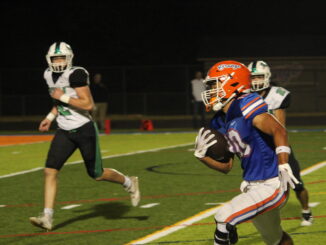
design: Jaylen Lewis
Zoning out of present situations and instead thinking about past scenarios happens more often to people than they would think. For many people, reminiscing about childhood brings back many unique and fond memories ranging from playing at playgrounds, swimming in pools and school.
The term used to describe this wistful and affectionate feeling to past experiences and sentiments is nostalgia, and a lot of mystery surrounds it, Therefore, research is still being done to get a better understanding.
“Nostalgia is feeling sentimental while reflecting on the past,” AP Psychology teacher Brooke Sandy said. “When we feel nostalgic, we are remembering the best parts of our past.”
When looking at why people reflect on nostalgic memories, especially of childhood, instead of living in the present, it is unique to each individual person, but there are some common trends. In some scenarios, people don’t even recognize that they are experiencing nostalgia.
“Looking back on our past can often help with loneliness, anxiety and boredom. It is an escape,” Sandy said. “It is generally enjoyable, and our brains often bring different memories to the surface even when we are not working to consciously recall them.”
Nostalgia also allows for interactions between different generations and just people in general. Talking with other people about their experiences is not only entertaining, but also useful.
“Going through our past with others also allows us to share our experiences and pass along stories to future generations and learn stories from older generations,” Sandy said.
Even though nostalgia has been proven to be harmless, and even good in most scenarios, for a long time before adequate research was performed, nostalgia was viewed in a negative light.
“Until more recent research, some people viewed nostalgia as people’s inability to accept and/or move on from the past and also taking away focus from their present lives/issues,” Sandy said. “For some individuals, nostalgia can bring about negative emotions, thoughts and dissatisfaction. However, many of the negative symptoms were correlated with nostalgia rather than caused by it.”
But, nostalgia is wholly unique to each individual, starting right down to if some people even experience nostalgia.
“Our brain seems to have a natural tendency to employ nostalgia and this varies by individual,” Sandy said. “There is actually an inventory that you can use to see how prone you are towards nostalgia.”
All generations experience nostalgia as they go back and remember other times. High schoolers may think back to easier times, but older generations go back to their youths where it was a different atmosphere.
Many teachers fit into the Generation X, which includes people who were born between around 1965 and 1980. Some may be considered millennials who would’ve been born from 1981 through 1997, or even Baby Boomers which includes people born before 1965.
It’s the world of big hair, Doc Martens, Walkmans, MTV, “Fresh Prince of Bel Air” and Michael Jackson. Marty McFly and the Doc teleport in from the 2010s, and back into the 80s.
The 80s/90s was the rise of pop culture, according to RedBook.com. Nickelodeon was dominating kids T.V while the Mickey Mouse Club had every kid dancing and singing and finding collectibles was every kid’s hobby.
“As a generation, we were the first who had access to video games and how it shaped culture,” history teacher Scott Tressler said, “As well as more forms of media and the beginning of reality T.V. (MTV’S Real World).”
Popular T.V. shows airing were “DuckTales”, “Ghostbusters”, “Beverly Hills”, “90210” and “Boy Meets World”. On the big screen, popular movies included “The Outsiders”, “The Breakfast Club”, “Sixteen Candles” and “Ferris Bueller’s Day Off”.
“Friday nights were called T.G.I.F. (Thank Goodness it’s Friday), and we would always get excited to watch shows like ‘Family Matters’ and ‘Full House’,” history teacher Rebecca Whitney said. “On Saturday mornings, it was a given to watch ‘Saved by the Bell’ and ‘The Golden Girls’ were also a pretty standard viewing.”
Many musicians like Michael Jackson and Madonna were peaking or rising to fame, creating trendy hit songs and even some now well-known classics like “Thriller” and “Material Girl”. Music was diverse with rock bands like Nirvana and Spin Doctors, to girl pop bands like Spice Girls and TLC and R&B singers like Aliyah, according to USA Today.
Boy bands were in their prime in the 90s, gathering massive fanbases. “When I was a kid, Brittany Spears was popular along with boy bands like NSYNC and Backstreet Boys,” science teacher Zachary Grubb said.
Old school rap was also coming into mainstream music. Missy Elliot, Ice Cube, TLC and En Vogue were some of the headliners.
“Our music is pretty iconic; bands like Green Day and Sublime seem to still be pretty popular,” Whitney said. “Live music such as shows at the Polaris Germain Amphitheater meant that we had access to more diversity in music, and many of us developed a wider taste in music as a result.”
Listening to music with friends was a fun activity to do along with the roller-skating rink and movie theaters. Riding bikes, playing kickball and ghosts in the graveyard were fun activities.
“I played a lot of soccer as a kid,” Grubb said. “We would often play croquet with my grandparents and card games.”
English Teacher Alicia Barden explained how kids would just go outside and simply play. No technology was in the discussion and they were raised in a community, like coaches and other parents; it was less isolated.
Technology is the biggest difference between Gen Z and generations in the past. It didn’t play an adamant role in society like it does now.
“Things are so public. People are quick to take videos and pictures and share them with the whole world, and I think that’s stressful to have that constantly hanging over your head in a phase of your life where you are prone to making mistakes or not always using the best judgement,” Whitney said. “The younger generations are also exposed to such a fast-paced environment that makes instant gratification more in demand.”
The Nokia 1011 was the blueprint for the modern-day phone. It was the first phone to have the first text message program.
“We used AOL instant messenger, and it was the dawn of social media and the idea that you could connect with people online,” Whitney said. “We all had pagers that you would be able to send a basic phone number to each other, but you had to use a landline phone to call someone back. So, we had to stop at payphones a lot or wait at home until we made definite plans to go out.”
Video game companies had consumers by their wallets with their mass appeal amongst kids. Video game consoles like the Nintendo Entertainment System and Nintendo Game Boy were fan favorites for video games.
Other gaming systems like Coleco and Atari were popular. VHS was also a widely used console.
The Super Nintendo came out in 1990 and was a big hit. “When I was a kid, I played video games on the Super Nintendo, N64 and Sega Genesis,” Grubb said.
Reminiscing back on childhood memories can bring back a nostalgic feeling, thinking about a life that seems so different from the one being lived today. It’s the memories that allow people to go back and enjoy those moments, and luckily for Doc and Marty McFly going back to those childhood memories won’t be an issue.
Generation Z, which includes students in high school, is now at an age where going back to their past experiences is appealing. Teens can find bits of happiness from their pasts by reminiscing about the nostalgic things that they all enjoyed during their childhood.
Some of the most distinct childhood memories were created in school. Kids remember vivid memories like recess with their friends, fun lessons taught in school or eating lunch with others.
“A lot of my most memorable childhood experiences were from when I played games outside with friends after school or during recess,” senior Saket Pochiraju said.
Getting active for 30 minutes outside of the classroom at recess was the highlight for many kids in a school day. Whether it was indoors or outdoors, kids enjoyed many iconic games that are looked fondly upon for years after.
“Some of my favorite games were the basketball games (21 and knockout), the soccer game (world cup), four corners and kickball,” Pochiraju said.
After school and weekends were a crucial part of any kid’s childhoods. They were able to let loose and let their imaginations and creativity run free.
“Coming back from the last day of school early, playing until it got dark in the street in front of our house and riding up the ‘Dirt Mountain’ when they were in the middle of constructing a new road are memories that I still look back on nostalgically,” Pochiraju said.
Waking up late on weekends and turning on favorite television shows were one of many memorable childhood recollections.
“Some of my favorite television shows as a kid were ‘Spongebob’, ‘Phineas and Ferb’ and ‘Full House’,” junior Luke Woolard said.
From a teen’s perspective, toys appear to be magical and crucial to any exciting childhood. Kids collected and played with many different types of toys.
“I loved playing with Hot-Wheels Cars, Nerf Guns, Beyblades and Pokemon cards,” Pochiraju said.
They would bring them over to their friend’s house or just use their imagination and play by themselves. From imagining being a fantasy character to making up random settings, a child has endless possibilities with the help of toys.
“Playing with toys with my little brother and friends were some of my favorite memories growing up,” Pochiraju said.
Video games further extended a child’s imaginative mind. Several past video games are considered classics by many. They allowed children to become anything they desired and play with their friends online.
“I played a lot of Nintendo games growing up. I played ‘Mario Kart’, ‘Wii Sports’, ‘Pokemon’ and much more,” senior Wenxin Zhang said.
Snacks played an early role in the enjoyment of food for kids. The wide smiles shown on their faces when they opened their lunchbox are memories cherished by many.
“Some of my favorite snacks are Pop Tarts, Fruit Snacks and Cheez-Its,” Woolard said.
Spending time with family is as important now as it was back then. Coming together and seeing family for the holidays created many fond memories that are still reminisced about today.
“I always enjoyed the holidays because I got to see my extended family and eat good food. My extended family has many different traditions that we fulfill every year. The week of Halloween, we always bob for apples, do a treasure hunt and swing a bat at a piñata. On Christmas Eve, we always open gifts, have a large family dinner and play a game of family football at the park,” Woolard said.
Many early childhood memories were created with friends. Kids can recall the memorable events from their childhood with friends but also just their daily playdates.
“My childhood was very action packed, as I got to try out a lot of different things and I enjoyed doing many different activities. I will always remember having fun with my friends whether it was at school recess, in my neighborhood or with my teammates on sports teams,” Woolard said.
Kids used their imaginative minds and created scenarios to be played out. Many would role-play games and tell creative stories.
“As a kid, I enjoyed exploring nature and playing cops and robbers with my friends and neighbors,” Pochiraju said.
Many iconic trends arose throughout the early childhood years. Some of them are looked back on fondly while others lead people to question themselves.
“Some memorable trends growing up that I remember were Nintendo DS and Wii, light-up Sketchers and Rainbow Loom bracelets,” Pochiraju said.
Overall, a memorable and great childhood contains many aspects that any kid will happily look back on. The childhood of current teens is filled with many rich and nostalgic memories.
When current adults look back at their childhood life compared to the lives of children today, there is one major difference: technology. Children these days have a variety of technology available to them: phones, ipads and computers allow them to have their own electronic devices at a young age.
“When I was in highschool, we didn’t have smart phones. MySpace and Facebook were launched, VR wasn’t a household technology, AI assistants/devices like Alexa, Google, and Siri weren’t a thing. Netflix sent DVDs by mail, and we had to watch TV series after they came out by buying or renting the box sets,” Sandy said.
The vast amount of technology available today, especially to children, isn’t entirely categorized as a “good” or “bad” notion. Like most things, there are not only positive and negative consequences from technology but also a lot of grey space regarding the topic.
Starting out positive, surfing through the internet, running through social media and playing digital games does seem to relieve stress in children and even entertains them.
“More recent research does suggest that utilizing technology regularly, especially social media and scrolling through our phones releases dopamine in the brain, leading people, especially children, to continually engage in the use of social media,” Sandy said.
Dopamine is a neurotransmitter, which are chemical messengers of the brain, that influences movement, learning, attention and emotion. Because of this, it is vital in both a person’s mental and physical well-being.
“If we are feeling down or bored, our brains will encourage us to seek an activity that we find enjoyable that releases those same neurotransmitters, reinforcing the habit of utilizing technology,” Sandy said.
As this leads to an increased use in technology, it could affect children physically as they would be less likely to get some fresh air and exercise to stay healthy. This is a threat for kids who don’t do any extracurriculars or know how to manage their time so that they aren’t always on technology.
“In a sense, children may not be as physically active thanks to technology like video games, leading to higher obesity rates,” Sandy said. “But in some ways, kids are more active given the variety of activities and club sports in addition to extracurriculars, so it depends on the child.”
Personality-wise, there is still a lot of research going on with how the use of technology could affect children mentally and how they act. Although, cyberbullying through social media has risen correlating with the increasing amount of technology, as kids find it easier to say something mean to their peers when it is not face-to-face. This in turn leads to rising levels of insecurity through kids.
But as most of the technology available in the present is relatively new, and kids that have grown up with technology are teenagers now at the oldest, long term effects of technology aren’t known for sure. But either way, technology is here to stay and will only get more advanced from here.
“Given that a lot of the technologies we are discussing are still fairly new, historically speaking, we are going to have to wait a bit longer for reliable longitudinal data to really tell us what the effects will be,” Sandy said. “But children need to be competent and comfortable with utilizing technology as it will certainly be a part of their future career in some capacity.”


